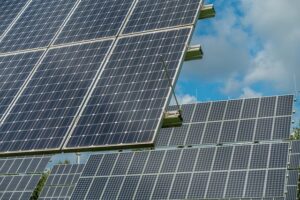
Exploring the Environmental Impact of Solar Panels
As the world grapples with climate change and seeks sustainable alternatives to fossil fuels, solar energy is becoming an increasingly popular choice. Solar panels convert sunlight into electricity, providing a renewable energy source that can significantly reduce greenhouse gas emissions. However, while solar panels are often lauded for their environmental benefits, it is essential to examine their entire lifecycle to understand their overall environmental impact.
The Lifecycle of Solar Panels
The environmental impact of solar panels can be broken down into several stages: raw material extraction, manufacturing, transportation, installation, operation, and end-of-life management. Each phase presents unique challenges and opportunities for reducing environmental harm.
Raw Material Extraction
Solar panels are primarily made from silicon, which is the second most abundant element in the Earth’s crust. However, the production of silicon involves significant energy consumption and environmental degradation. The extraction of silicon often involves mining quartz sand, which can lead to habitat destruction, soil erosion, and water pollution.
Moreover, silicon is not the only material used in solar panels. Other components such as metals (copper, silver, and aluminum) and glass also form a crucial part of solar panel construction. The mining of these metals can have considerable environmental consequences, including habitat destruction, and toxic chemical runoff. Furthermore, methods used in mining and refining processes can lead to air and water pollution, affecting local ecosystems and communities.
Manufacturing
The manufacturing process of solar panels involves significant energy input and often relies on non-renewable sources of energy. The production of photovoltaic (PV) cells, which convert sunlight into electricity, typically involves several chemical processes that can produce pollutants. These processes may release harmful substances like hydrogen fluoride and silicon tetrachloride into the environment.
Furthermore, the manufacturing stages can contribute to carbon emissions, particularly if the energy used in production is generated from fossil fuels. However, advancements in technology and a shift towards renewable energy sources for manufacturing processes can mitigate some of these environmental impacts.
Transportation
Once manufactured, solar panels must be transported to their installation sites. This transportation phase can also contribute to their carbon footprint. The distance traveled, modes of transport employed (trucking, shipping, etc.), and packaging materials all play a role in the environmental impact of transportation. Sustainable practices and local sourcing can help reduce these emissions.
Installation
The installation of solar panels generally has a low immediate environmental impact. However, the land area required for large solar farms can lead to habitat disruption, particularly if they are sited in sensitive ecosystems. Careful planning is essential to minimize ecological disruption, such as avoiding important wildlife habitats and agricultural lands.
Operation
During their operational life, solar panels generate clean energy without emitting greenhouse gases or producing air pollutants. A typical solar panel system can offset a significant amount of carbon emissions compared to fossil fuel-based energy sources. The operational life of solar panels usually spans 25 to 30 years, during which they generate solar power that displaces electricity from coal, natural gas, or oil, substantially lowering emissions.
End-of-Life Management
The end of a solar panel’s life presents one of the most significant environmental challenges associated with their use. After approximately 25 to 30 years, solar panels can become less efficient or fail entirely. This leads to a growing concern regarding how to dispose of or recycle these modules. The improper disposal of solar panels can lead to hazardous materials entering the environment, such as heavy metals and toxic chemicals.
Currently, the recycling infrastructure for solar panels is in its infancy. However, technological innovations are emerging to improve the recycling processes. Companies are developing methods to recover valuable materials from end-of-life panels, thereby reducing waste and conserving resources. Initiatives to create circular economies for solar technology are essential to lessen their environmental footprint.
Benefits of Solar Panels
Despite the environmental concerns associated with their lifecycle, solar panels offer numerous environmental benefits. One of the most significant advantages is their potential to reduce greenhouse gas emissions and combat climate change. By harnessing renewable energy from the sun, solar panels can provide electricity without contributing to air pollution or relying on finite fossil fuels.
Solar energy systems can also enhance energy independence by diversifying energy supply sources. Reducing dependence on imported fossil fuels can bolster national security and energy resilience. Additionally, the growth of the solar industry promotes job creation in manufacturing, installation, and maintenance, providing economic benefits alongside environmental advantages.
Comparative Analysis: Solar vs. Other Energy Sources
When compared to traditional energy sources, solar panels generally have a far lower overall impact on the environment. Coal, oil, and natural gas not only emit greenhouse gases but also release particulate matter and toxic pollutants that can severely affect air quality and public health. Furthermore, fossil fuel extraction processes, including drilling and fracking, can lead to environmental destruction, water contamination, and habitat loss.
Wildlife impacts are also critical when evaluating energy production methods. Wind and solar energy have lesser impacts on wildlife, especially when compared to fossil fuel extraction. Coal mining can lead to catastrophic destruction of landscapes and wildlife habitats, while oil spills pose ongoing threats to marine ecosystems.
Future Outlook
The transition to using solar energy is essential for a sustainable future. As technology advances, solar panels are expected to become more efficient, less expensive, and easier to recycle. Continuous research and innovation in solar technology will play a crucial role in addressing environmental challenges from raw material extraction to end-of-life management.
Policies that encourage sustainable practices within the solar industry, such as incentivizing recycling and promoting renewable energy sources in production, can drive further improvements in the environmental impact of solar panels. Public awareness and support for solar energy adoption can also push for regulatory frameworks that ensure environmentally sound practices across the solar panel lifecycle.
Conclusion
Solar panels represent a vital element in the clean energy transition, offering a renewable solution to the pressing challenges of climate change and environmental degradation. While their lifecycle presents certain environmental impacts that require attention, the benefits of solar energy are profound. By understanding and addressing these challenges, society can harness the potential of solar energy while minimizing its environmental footprint. Embracing solar energy provides a path towards a cleaner, sustainable future.



